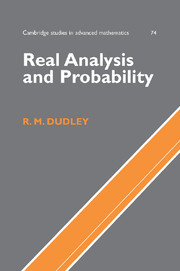Book contents
- Frontmatter
- Contents
- Preface to the Cambridge Edition
- 1 Foundations; Set Theory
- 2 General Topology
- 3 Measures
- 4 Integration
- 5 Lp Spaces; Introduction to Functional Analysis
- 6 Convex Sets and Duality of Normed Spaces
- 7 Measure, Topology, and Differentiation
- 8 Introduction to Probability Theory
- 9 Convergence of Laws and Central Limit Theorems
- 10 Conditional Expectations and Martingales
- 11 Convergence of Laws on Separable Metric Spaces
- 12 Stochastic Processes
- 13 Measurability: Borel Isomorphism and Analytic Sets
- Appendix A Axiomatic Set Theory
- Appendix B Complex Numbers, Vector Spaces, and Taylor's Theorem with Remainder
- Appendix C The Problem of Measure
- Appendix D Rearranging Sums of Nonnegative Terms
- Appendix E Pathologies of Compact Nonmetric Spaces
- Author Index
- Subject Index
- Notation Index
- References
6 - Convex Sets and Duality of Normed Spaces
Published online by Cambridge University Press: 06 July 2010
- Frontmatter
- Contents
- Preface to the Cambridge Edition
- 1 Foundations; Set Theory
- 2 General Topology
- 3 Measures
- 4 Integration
- 5 Lp Spaces; Introduction to Functional Analysis
- 6 Convex Sets and Duality of Normed Spaces
- 7 Measure, Topology, and Differentiation
- 8 Introduction to Probability Theory
- 9 Convergence of Laws and Central Limit Theorems
- 10 Conditional Expectations and Martingales
- 11 Convergence of Laws on Separable Metric Spaces
- 12 Stochastic Processes
- 13 Measurability: Borel Isomorphism and Analytic Sets
- Appendix A Axiomatic Set Theory
- Appendix B Complex Numbers, Vector Spaces, and Taylor's Theorem with Remainder
- Appendix C The Problem of Measure
- Appendix D Rearranging Sums of Nonnegative Terms
- Appendix E Pathologies of Compact Nonmetric Spaces
- Author Index
- Subject Index
- Notation Index
- References
Summary
Functional analysis is concerned with infinite-dimensional linear spaces, such as Banach spaces and Hilbert spaces, which most often consist of functions or equivalence classes of functions. Each Banach space X has a dual space X′ defined as the set of all continuous linear functions from X into the field ℝ or ℂ.
One of the main examples of duality is for Lp spaces. Let (X, S, μ) be a measure space. Let 1 < p < ∞ and 1/p + 1/q = 1. Then it turns out that Lp and Lq are dual to each other via the linear functional f ↦ ∫ f g d μ for f in p and g in q. For p = q = 2, L2 is a Hilbert space, where it was shown previously that any continuous linear form on a Hilbert space H is given by inner product with a fixed element of H (Theorem 5.5.1).
Other than linear subspaces, some of the most natural and frequently applied subsets of a vector space S are the convex subsets C, such that for any x and y in C, and 0 < t < 1, we have tx + (1 – t)y ∈ C. These sets are treated in §§6.2 and 6.6. A function for which the region above its graph is convex is called a convex function. §6.3 deals with convex functions. Convex sets and functions are among the main subjects of modern real analysis.
- Type
- Chapter
- Information
- Real Analysis and Probability , pp. 188 - 221Publisher: Cambridge University PressPrint publication year: 2002



